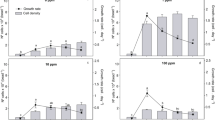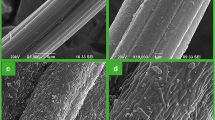Abstract
Based on ecological niche theory, Microcystis Aeruginosa (MA) immobilized in the complex of polyvinyl alcohol (PVA) and sodium alginate (SA) crosslinked by CaCl2, was treated as a new kind of special species, and its properties were investigated. Chlorophyll a was used to characterize the bioactivity of the immobilized MA. Results reveal that the gel beads have mechanical strength and chemical stability even under non-sterile harsh conditions, which may be attributed to the rarely seen structure (including three different layers: dense surface, tubular-shaped divergent structure and honeycomb crystal lattice layer) of the immobilized MA determined by scanning electron microscope (SEM). SEM also displays that more quantity of MA is attached to the inwall after cultivation, which demonstrates that the MA within beads maintains high bioactivity. Removal capacities on phosphorous (P) removal in wastewater in the presence and absence of the BG-11 medium were examined, and the removal ratios are 80.3% and 76.7%, respectively, which indicates that the beads without providing ample nutrients still have high capacity of P removal. In addition, control experiment, utilizing polyvinyl alcohol and sodium alginate (PVA-SA) beads without immobilized MA, demonstrates that MA within beads plays the key role in absorbing P.
Similar content being viewed by others
References
HE Qiang, ZHANG Ting-ting, CHAI Hong-xiang, YANG Shi-wei, ZHOU Jian, DU Guo-jun. Pretreatment of hypersaline mustard wastewater with integrated bioreactor [J]. Journal of Central South University, 2012, 19(6): 1673–1678.
BECHMANN M E, BERGE D, EGGESTAD H O, VANDSEMB S M. Phosphorus transfer from agricultural areas and its impact on the eutrophication of lakes-Two long-term integrated studies from Norway [J]. Journal of Hydrology, 2005, 304(1/2/3/4): 238–250.
GARNIER J, NEMERY J, BILLEN G, THERY S. Nutrient dynamics and control of eutrophication in the Marne River system: Modelling the role of exchangeable phosphorus [J]. Journal of Hydrology, 2005, 304(1/2/3/4): 397–412.
HOSNI K, MOUSSA S B, AMOR M B. Conditions influencing the removal of phosphate from synthetic wastewater: Influence of the ionic composition [J]. Desalination, 2007, 206(1/2/3): 279–285.
JARVIE H P, NEAL C, WITHERS P J A. Sewage-effluent phosphorus: A great risk to river eutrophication than agricultural phosphorus? [J]. Science of the Total Environment, 2006, 360(1/2/3): 246–253.
LESTON S, LILLEBO A I, PARDAL M A. The response of primary producer assemblages to mitigation measures to reduce eutrophication in a temperate estuary [J]. Estuarine, Coastal and Shelf Science, 2008, 77(4): 688–696.
MAINSTONE C P, PARR W. Phosphorus in rivers-Ecology and management [J]. Science of the Total Environment, 2002, 282/283: 25–47.
YOUNG K, MORSE G K, SCRIMSHAW M D, KINNIBURGH J H, MACLEOD C L, LESTER J N. The relation between phosphorus and eutrophication in the Thames catchment, UK [J]. Science of the Total Environment, 1999, 228(2/3): 157–183.
KAGALOU I, PAPASTERGIADOU E, LEONARDOS I. Long term changes in the eutrophication process in a shallow Mediterranean lake ecosystem of W. Greece: Response after the reduction of external load [J]. Journal of Environmental Management, 2008, 87(3): 497–506.
LEE J, CHO M H. Removal of nitrogen in wastewater by polyvinyl alcohol (PVA)-immobilization of effective microorganisms [J]. Korean Journal of Chemical Engineering, 2010, 27(1): 193–197.
BAO Lin-lin, LI Dong, LI Xiang-kun, HUANG Rong-xin, ZHANG Jie, LV Yang, XIA Guang-qing. Phosphorus accumulation by bacteria isolated from a continuous-flow two-sludge system [J]. Journal of Environmental Sciences, 2007, 19(4): 391–395.
LAI D Y E, LAM K C. Phosphorus sorption by sediments in a subtropical constructed wetland receiving stormwater runoff [J]. Ecological Engineering, 2009, 35(5): 735–743.
LU S Y, WU F C, LU Y F, XIANG C S, ZHANG P Y, JIN C X. Phosphorus removal from agricultural runoff by constructed wetland [J]. Ecological Engineering, 2009, 35(3): 402–409.
RAZALI M, ZHAO Y Q, BRUEN M. Effectiveness of a drinking-water treatment sludge in removing different phosphorus species from aqueous solution [J]. Separation and Purification Technology, 2007, 55(3): 300–306.
ROSENQUIST S E, HESSION W C, EICK M J, VAUGHAN D H. Variability in adsorptive phosphorus removal by structural stormwater best management practices [J]. Ecological Engineering, 2010, 36(5): 664–671.
XIAO Guang-li, LI Ting-xuan, ZHANG Xi-zhou, YU Hai-ying, HUANG Hua-gang, GUPTA D K. Uptake and accumulation of phosphorus by dominant plant species growing in a phosphorus mining area [J]. Journal of Hazardous Materials, 2009, 171(1/2/3): 542–550.
ZHAO X H, ZHAO Y Q. Investigation of phosphorus desorption from P-saturated alum sludge used as a substrate in constructed wetland [J]. Separation and Purification Technology, 2009, 66(1): 71–75.
LIU Y J, ZHANG A N, WANG X C. Biodegradation of phenol by using free and immobilized cells of Acinetobacter sp. XA05 and Sphingomonas sp. FG03 [J]. Biochemical Engineering Journal, 2009, 44(2/3): 187–192.
ROSTRON W M, STUCKEY D C, YOUNG A A. Nitrification of high strength ammonia wastewaters: Comparative study of immobilization media [J]. Water Research, 2001, 35(5): 1169–1178.
SEO J K, JUNG I H, KIM M R, KIN B J, NAM S W, KIM S K. Nitrification performance of nitrifiers immobilized in PVA (polyvinyl alcohol) for a marine recirculating aquarium system [J]. Aquacultural Engineering, 2002, 24(3): 181–194.
HSU H F, JHUO Y S, KUMAR M, MA Y S, LIN J G. Simultaneous sulfate reduction and copper removal by a PVA-immobilized sulfate reducing bacterial culture [J]. Bioresource Technology, 2010, 101(12): 4354–4361.
ZAIN N A M, SUARDI S M, IDRIS A. Hydrolysis of liquid pineapple waste by invertase immobilized in PVA-alginate matrix [J]. Biochemical Engineering Journal, 2010, 50(3): 83–89.
CHANG I S, KIM C I, NAM B U. The influence of poly-vinyl-alcohol (PVA) characteristics on the physical stability of encapsulated immobilization media for advanced wastewater treatment [J]. Process Biochemical, 2005, 40(9): 3050–3054.
CHEN C Y, CHEN S C, FINGAS M, KAO C M. Biodegradation of propionitrile by Klebsiella oxytoca immobilized in alginate and cellulose triacetate gel [J]. Journal of Hazardous Materials, 2010, 177(1/2/3): 856–863.
CHEN K C, LEE S C, CHIN S C, HOUNG J Y. Simultaneous carbon-nitrogen removal in wastewater using phosphorylated PVA-immobilized microorganisms [J]. Enzyme and Microbial Technology, 1998, 23(5): 311–320.
JEON C, PARK J Y, YOO Y J. Novel immobilization of alginic acid for heavy metal removal [J]. Biochemical Engineering Journal, 2002, 11(2/3): 159–166.
DURSUN A Y, TEPE O. Internal mass transfer effect on biodegradation of phenol by Ca-alginate immobilized Ralstonia eutropha [J]. Journal of Hazardous Materials, 2005, 126(1/2/3): 105–111.
BAI Xue, YE Zheng-fang, LI Yan-feng, ZHOU Lin-cheng, YANG Liu-qing. Preparation of crosslinked macroporous PVA foam carrier for immobilization of microorganisms [J]. Process Biochemistry, 2010, 45(1): 60–66.
WANG Yu-jian, YANG Xiao-juan, TU Wei, LI Hong-yu. High-rate ferrous iron oxidation by immobilized Acidithiobacillus ferrooxidans with complex of PVA and sodium alginate [J]. Journal of Microbiological Methods, 2007, 68(2): 212–217.
ZHANG Li-sheng, WU Wei-zhong, WANG Jian-long. Immobilization of activated sludge using improved poly-vinyl alcohol (PVA) gel [J]. Journal of Environmental Sciences, 2007, 19(11): 1293–1297.
CAO Guo-min, ZHAO Qing-xiang, SUN Xian-bo, ZHANG Tong. Characterization of nitrifying and denitrifying bacteria coimmobilized in PVA and kinetics model of biological nitrogen removal by coimmobilized cells [J]. Enzyme and Microbial Technology, 2002, 30(1): 49–55.
CHEN K C, WU J Y, HUANG C C, LIANG Y M, HWANG S C J. Decolorization of azo dye using PVA-immobilized microorganisms [J]. Journal of Biotechnology, 2003, 101(3): 241–252.
KUYUKINA M S, IVSHINA I B, GAVRIN A Y, PODOROZHKO E A, LOZINSKY V I, JEFFREE C E, PHILP J C. Immobilization of hydrocarbon-oxidizing bacteria in poly(vinyl alcohol) cryogels hydrophobized using a biosurfactant [J]. Journal of Microbiological Methods, 2006, 65(3): 596–603.
LONG Zong-er, HUANG Yun-hong, CAI Zhao-ling, CONG Wei, OUYANG Fan. Immobilization of Acidithiobacillus ferrooxidans by a PVA-boric acid method for ferrous sulphate oxidation [J]. Process Biochemistry, 2004, 39(12): 2129–2133.
LOZINSKY V I, PLIEVA F M. Poly(vinyl alcohol) cryogels employed as matrices for cell immobilization. 3. Overview of recent research and developments [J]. Enzyme and Microbial Technology, 1998, 23(3/4): 227–242.
ZHANG Zhen-ya, LEI Zhong-fang, HE Xiao-yan, ZHANG Zhi-yin, YANG Ying-nan, SUGIURA N. Nitrate removal by Thiobacillus denitrificans immobilized on poly (vinyl alcohol) carriers [J]. Journal of Hazardous Materials, 2009, 163(2/3): 1090–1095.
IZYDORARCZYK K, CARPENTIER C, MROWCZYNSKI J, WAGENVOORT A, JURCZAK T, TARCZYNSKA M. Establishment of an Alert level Framework for cyanobacteria in drinking water resources by using the Algae Online Analyser for monitoring cyanobacterial chlorophyll a [J]. Water Research, 2009, 43(4): 989–996.
LICHTENTHALER H K, BUSCHMANN C. Chlorophylls and carotenoids: Measurement and characterisation by UV-VIS spectroscopy, current protocols in food analytical chemistry (CPFA) [M]. New York: John Wiley, 2001.
KHOO K M, TING Y P. Biosorption of gold by immobilized fungal biomass [J]. Biochemical Engineering Journal, 2001, 8(1): 51–59.
HUANG Xiao-jun, GE Dan, XU Zhi-kang. Preparation and characterization of stable chitosan nanofibrous membrane for lipase immobilization [J]. European Polymer Journal, 2007, 43(9): 3710–3718.
IDRIS A, ZAIN N A M, SUHAIMI M S. Immobilization of Baker’s yeast invertase in PVA-alginate matrix using innovative immobilization technique [J]. Process Biochemistry, 2008, 43(4): 331–338.
XIE Wei-min, WANG Qun-hui, MA Hong-zhi, OHSUMI Y, OGAWA H I. Study on phosphorus removal using a coagulation system [J]. Process Biochemistry, 2005, 40(8): 2623–2627.
ABE K, TAKIZAWA H, KIMURA S, HIRANO M. Characteristics of chlorophyll formation of the aerial microalga Coelastrella striolata var. multistriate and its application for environmental biomonitoring [J]. Journal of Bioscience and Bioengineering, 2004, 98(1): 34–39.
BACKOR M, KLEMOVA K, BACKOROVA M, IVANOVA V. Comparison of the phytotoxic effects of usnic acid on cultures of free-living alga Scenedesmus quadricauda and aposymbiotically grown lichen photobiont Trebouxia erici [J]. Journal of Chemical Ecology, 2010, 36(4): 405–411.
COX H H J, DESHUSSES M A. Co-treatment of H2S and toluene in a biotrickling filter [J]. Chemical Engineering Journal, 2002, 87(1): 101–110.
KIM Y S, KIM H W, LEE S H, SHIN K S, HUR H W, RHEE Y H. Preparation of alginate-quaternary ammonium complex beads and evaluation of their antimicrobial activity [J]. International Journal of Biological Macromolecules, 2007, 41(1): 36–41.
SRIAMORNSAK P, NUNTHANID J, LUANGTANA-ANAN M, PUTTIPIPATKHACHORN S. Alginate-based pellets prepared by extrusion/spheronization: A preliminary study on the effect of additive in granulating liquid [J]. European Journal of Pharmaceutics and Biopharmaceutics, 2007, 67(1): 227–235.
BAI Xue, YE Zheng-fang, QU Yan-zhi, LI Yan-feng, WANG Zhong-you. Immobilization of nanoscale Fe0 in and on PVA microspheres for nitrobenzene reduction [J]. Journal of Hazardous Materials, 2009, 172(2/3): 1357–1364.
WANG Yu-jian, YANG Xiao-juan, LI Hong-yu, TU Wei. Immobilization of Acidithiobacillus ferrooxidans with complex of PVA and sodium alginate [J]. Polymer Degradation and Stability, 2006, 91(10): 2408–2414.
TIAN Xin, LIAO Qiang, LIU Wei, WANG Yong-zhong, ZHU Xun, LI Jun, WANG Hong. Photo-hydrogen production rate of a PVA-boric acid gel granule containing immobilized photosynthetic bacteria cells [J]. International Journal of Hydrogen Energy, 2006, 34(11): 4708–4717.
GUO Ni-chun, XIE Ping. Development of tolerance against toxic Microcystis aeruginosa in three cladocerans and the ecological implications [J]. Environmental Pollution, 2006, 143(3): 513–518.
Author information
Authors and Affiliations
Corresponding author
Additional information
Foundation item: Projects(51178172, 51308076) supported by the National Natural Science Foundation of China; Project(13JJ4107) supported by Hunan Provincial Natural Science Foundation, China; Project(K1207026-31) supported by Changsha Planning Project of Science and Technology, China
Rights and permissions
About this article
Cite this article
Li, F., Mao, Wj., Li, X. et al. Characterization of Microcystis Aeruginosa immobilized in complex of PVA and sodium alginate and its application on phosphorous removal in wastewater. J. Cent. South Univ. 22, 95–102 (2015). https://doi.org/10.1007/s11771-015-2499-5
Received:
Accepted:
Published:
Issue Date:
DOI: https://doi.org/10.1007/s11771-015-2499-5




